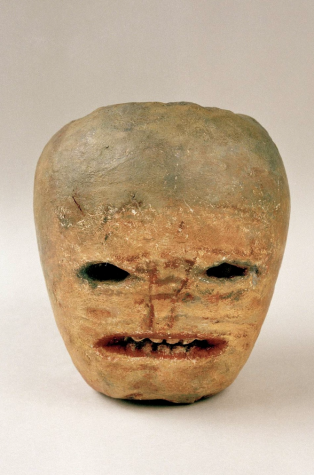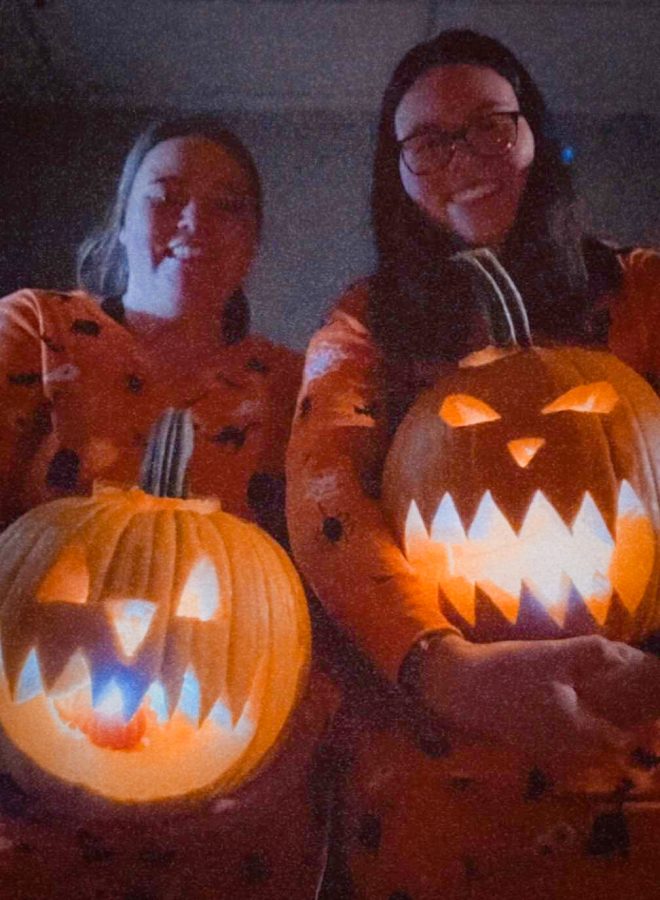Pumpkins with a history
After a trip to the pumpkin patch, graduate student Molly Burger and her girlfriend Kelsey Pacetti proudly show off their jack-lanterns while wearing Halloween pajamas.
October 30, 2022
It’s the Halloween season. You’re dreaming of eating some candy while the fallen leaves crackle under your feet. The sun’s going down early, but not to fear. You can still see in front of you. Pumpkins with carved smiles light your path. Jack-o’-lanterns have been a long-standing tradition during the fall season.
“This year my girlfriend and I went to a cute little place called Skelly’s to find pumpkins to carve. We ended up spending like two hours there because we wanted to buy all of them,” said UWW graduate student Molly Burger. “I enjoyed thinking of ideas of things to carve into my pumpkin. We thought we both got super creative; but we ended up creating the same design, which I thought was cute.”
Whitewater, like many other college towns, is no stranger to carving pumpkins. The Second Salem of the United States embraces all things spooky. The activity serves as a way to bond for organizations and friend groups alike. It’s common to see several walking through the campus.

(National Museum of Ireland)
Though the history of the jack-o’-lantern has a convoluted past, most historians credit Ireland for the creation of them. In modern days, pumpkins are the sole medium for jack-o’-lanterns; but turnips, potatoes, and other root vegetables were the original vehicle. Samhain, a Celtic festival, was a night for the dead to once again walk the earth. The living, not wanting an unsavory visit from these spirits, donned masks and carved vegetables to scare away unwanted visitors. (Traynor, 2019)
The most notable of these eerie beings is a man nicknamed “Stingy Jack.” In legend, Jack was the most looked-down-upon man in his village. At the end of his life, the Devil came to collect Jack’s soul; but the sleazy commoner convinced the Devil to share one last drink with him. At the end of their encounter, Jack convinced the Devil to turn himself into a coin that could be used to buy the drinks. But true to his name, Stingy Jack kept the coins with the Devil contained inside with a silver cross next to them, which ensured he could not escape.
After letting the Devil go, Jack lived for ten more years before the time to collect his soul came again. Not learning his lesson, the Devil was once more tricked by Jack who trapped him atop an apple tree. Once released, Stingy Jack was promised again to be left alone for ten years. Only after, the Devil would not allow the trickster to enter Hell. God, too, turned the sinner away from Heaven.
“Jack, with all his skill, could not baffle the assault of Death. He paid the debt of nature; but when his soul was dismissed to its final residence, the porter at the gate of the infernal regions stoutly denied him admittance – the fiends turned pale with affright – and even Satan himself fled within the lowest depths [Tartarus perhaps?] to hide his head from the dreaded enemy. Then, because he was unfit for heaven, and that hell refused to take him, he was decreed to walk the earth with a lantern to light him on his nightly way until the day of judgement – Such, reader, is the legend relative to the Jack-o’-the-Lantern…” (Dublin Penny Journal, 1836)
Though the tradition started far from what most of us see as home, pumpkin carving has fully planted its roots in what we know as Halloween. As Irish immigrants moved to the United States, they discovered that a native fruit to America, pumpkins, worked perfectly to carve jack-o’-lanterns. (History)
“I carved pumpkins just this last weekend! It was very challenging and took a long time because we decided against spending any money on a carving kit. It was still fun though,” said junior Ray Schroeder. “This is actually the first time I’ve ever carved pumpkins because I never knew how to do it before.”
Whether it be your first or 20th time creating a jack-o-lantern, the long-standing history of the practice helps to create memories today. Next time you pick up carving materials to shape a smile on a pumpkin, remember to thank Stingy Jack for it. Or don’t. Maybe he’ll pay you a visit instead.
History.com Editors. (2019, October 25). How Jack O’Lanterns originated in Irish myth. History.com. Retrieved October 25, 2022, from https://www.history.com/news/history-of-the-jack-o-lantern-irish-origins
Traynor, J. (2019, October 29). The story of Jack-O’-lantern: ‘if you knew the sufferings of that Forsaken Craythur’. The Irish Times. Retrieved October 25, 2022, from https://www.irishtimes.com/life-and-style/abroad/the-story-of-jack-o-lantern-if-you-knew-the-sufferings-of-that-forsaken-craythur-1.4065773
W., E. (1836). Jack o’ The lantern. The Dublin Penny Journal, 4(185), 229–232. https://doi.org/10.2307/30004104













